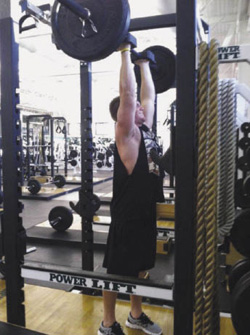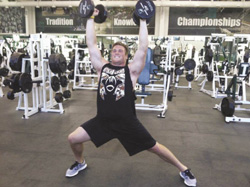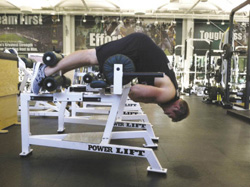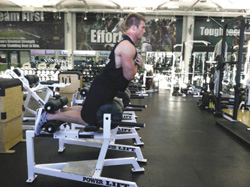Powerline: Utilizing a multi-joint combo routine
It’s no secret that one of best ways to increase overall strength and add some good, solid, power-producing muscle weight is to focus on resistance movements that engage the body’s larger muscle groups.
But, to do this effectively, the incorporation of multi-joint movements — exercises that stimulate musculature crossing at least two joints — must be called upon.
The “full metal jacket combo” combo entails five total exercises that effectively train the major muscular compartments of the legs, hips, lower back, vital core structures, and to a lesser extent, a portion of the upper torso, arms and shoulder musculature.Simply put, a lot of good training is taking place for many of the structures that matter in athletics. It’s truly a comprehensive, well-rounded routine for its purpose — hence, the moniker, full metal jacket.

Leg presses
Instruct athletes to extend their legs just short of the lockout position. First up is a solid set of leg presses for 12 reps. The weight selection should be such that that last few reps are difficult to achieve, but are completed.
On leg presses (photo 1), we instruct our athletes to extend their legs to just short of the lockout position and pause there for at least a second. This should prevent any issues of posterior knee stress, as well as ensure a smooth transition to the eccentric (lowering) phase of the movement. The eccentric phase is performed on a three- to four-second count, so as to emphasize that segment of the exercise and increase the TUL.

Heavy bag squats
Have the athlete maintain a relatively flat upper and lower back. After the allotted recovery time, a set of heavy bag squats (photo 2) is performed for 15 reps. The bag shown here weighs 75 pounds and it has handles of various sizes, shapes, widths and angles to accommodate a host of different exercises. It is well-suited for both front and back squats.
The athlete is instructed to maintain a relatively flat upper and lower back — while locking-in the normal curvature of the lumbar spine — and to pull the shoulders back, keeping the chest high and big. We want a thigh parallel to the floor position at mid-range, and a shoulder and chest upward lead from that point.

Front squat/press
The front squat is the first part of this true multi-joint exercise. The exercise concludes by extending the hips and arms.
Next up is the log bar front squat/press (photo 3-4), which is an old-school, garage training favorite of mine. It is, in my opinion, one of the better, true multi-joint exercises in strength training. It engages not only the large muscle compartments of the legs and hips, but it also calls on the stabilizers of the lower back and upper torso, and directly activates the arms and shoulders in the pressing phase.

Using the neutral-handled log bar, the lifter racks the bar on the anterior shoulder region, maintains the same posture as mentioned in the back squat, sits down and back to the parallel position (photo 3), and simultaneously extends the legs, hips and arms through the raising phase of the movement (photo 4).
In this particular routine, we want 10 perfectly performed reps with moderate weight, so as not to compromise technique and body posture.
Lunge matrix
Use dumbbells to have your athlete perform a series of lunge presses. Photo 5 shows us at 3 o’clock. With three really good, challenging exercises completed, the lunge matrix steps in to make further inroads.

With the use of two manageable dumbbells (DBs), a series of lunge/presses are performed in matrix fashion. The lifter begins the process with the mindset that he or she is standing in the center of a large clock. The first lunge step is taken with the right leg straight ahead to the 12-o’clock position, where a lunge/press is performed (i.e., as the lunge is executed, a shoulder press also is performed with the DBs).
The lifter then steps back to the center of the clock, gets under control and then lunge/presses to the 1-o’clock position. The process continues until the lifter has performed all of the time settings on the right face of the clock (i.e., 12, 1, 2, etc.), and then works the left leg through all of the time settings on the left side of the clock (i.e., 12, 11, 10, etc.). Two circuits down each side of the clock are executed (14 total reps for each leg).
We teach a parallel lunge position, with the heel of the foot flat on the floor, and the toes slightly ahead of the knee when possible.
Glute/ham raises

The routine is completed with glute/ham raises, an excellent movement for many of the posterior chain complexes. You can see the nice stretch provided for all of these compartments in the starting position (photo 6).
As the lifter initiates the movement to the parallel position and finally to the slightly angled upright posture (photo 7), a sequential firing of the hamstring, gluteal and low back muscles is taking place. We ask for 10 to 12 reps on this movement to complete training cycle.

It’s important to maintain a relatively flat back posture once the movement is initiated, and especially through the final phase from the parallel position through the completion (photo 7).
Final rep
Full metal jacket can be used in both the offseason and in-season periods with attention given to rep and set volume. During the offseason, higher rep volume and multi-cycles (two to three cycles through the entire routine) can be performed, depending upon any other lifting emphasis and running volume that is concurrently implemented.
As an in-season routine, the rep volume can be slightly reduced, if deemed necessary, and one or two cycles — at the most — proves to be more than sufficient on any lower body emphasis training day.
Ken Mannie is the head strength and conditioning coach Michigan State University. His column, Powerline, appears regularly in Coach & Athletic Director magazine.


